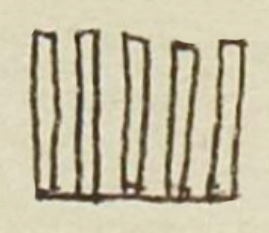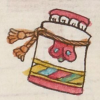Xelhuan (MH536r)
This black-line drawing is the simplex glyph for the personal name Xelhuan (or Xelhua, seen both ways). The glyph consists of five upright, narrow rectangles, connected at the base with a horizontal line. Here, it is attested here as a man’s name. He is apparently named after a figure in Nahua origin stories. The upright rectangles may have something to do with objects that are being distributed (relating to the verb, xeloa). These also appear to be numerical markers, such as the Macuil glyph, below.
Stephanie Wood
Other glyphs for Xelhuan can show quetzal feathers or a feathered headdress, so perhaps these narrow, vertical rectangles are stylized feathers. Xelhua or Xelhuan was the name of a a figure who has been interpreted as a mythical giant, prince, or "deity," the son of Ilancueitl, and someone active in the Tehuacan Valley. [See Emily Umberger, "Aztec Presence and Material Remains in the Outer Provinces," in Aztec Imperial Strategies, ed. Frances Berdan (1996, 170).] Some believe he survived a flood by climbing Mount Tlaloc, and some say he organized the construction of the huge pyramid at Cholula. Our Online Nahuatl Dictionary also reports that Xelhuan was the name of: "a Nonoalca Chichimeca who settled in Tula with three other Nonoalcas and four Tolteca Chichimecas, according to the Historia Tolteca Chichimeca or Anales de Cuauhtinchan." A feathered headdress would align with memories of the Chichimeca people that were held by sedentary central Mexicans.
Stephanie Wood
diego xelhuā
Diego Xelhuan
Stephanie Wood
1560
Jeff Haskett-Wood
divide, dividir, distribute, distribuir, ones, unos, counters, marcadores, nombres de hombres

Xelhuan, name, https://nahuatl.wired-humanities.org/content/xelhuan
xeloa, to divide or distribute, https://nahuatl.wired-humanities.org/content/xeloa
(el nombre de un ancestro Chichimeca)
Stephanie Wood
Matrícula de Huexotzinco, folio 536r, https://www.loc.gov/resource/gdcwdl.wdl_15282/?sp=151&st=image
This manuscript is hosted by the Library of Congress and the World Digital Library; used here with the Creative Commons, “Attribution-NonCommercial-ShareAlike 3.0 License” (CC-BY-NC-SAq 3.0).







